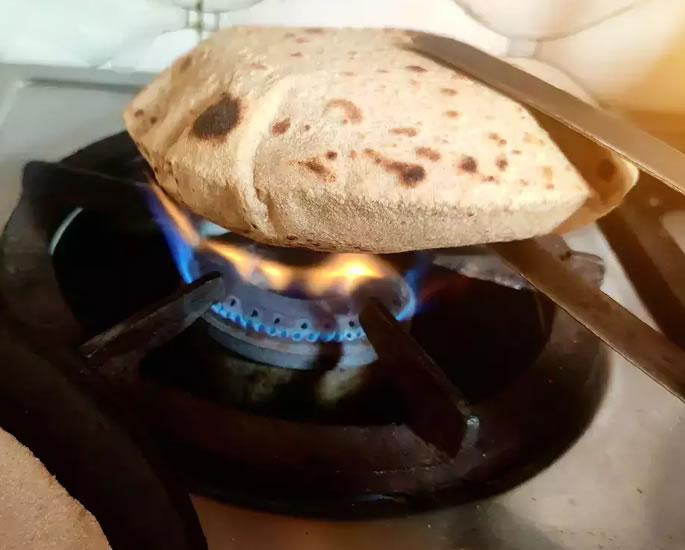It is a staple food in these regions
In the realm of diverse dietary practices, few staples hold as significant a place as the humble chapati.
A fixture on the plates of millions, this traditional flatbread is a dietary mainstay for many cultures.
But can one enjoy the comfort of daily chapati consumption and still embark on a successful weight loss journey?
We delve into the intersection of culinary tradition and modern health goals, offering a comprehensive array of insightful tips and strategies to navigate weight loss while keeping chapatis a cherished part of your daily routine.
Check out the secrets to harmonising tradition with progress and discover how the art of balanced eating can coalesce with your desire to shed those extra pounds.
What is a Chapati?
Also known as roti, it is a type of unleavened flatbread that is commonly consumed in South Asia, particularly in countries like India, Pakistan, Nepal, Bangladesh, and Sri Lanka.
It is a staple food in these regions and is often served as an accompaniment to various dishes.
Chapatis are made from whole wheat flour, water, and a bit of salt. The dough is kneaded and then rolled out into thin, circular shapes.
These thin dough rounds are then cooked on a hot griddle or skillet until they puff up and develop brown spots on both sides.
The cooking process is relatively quick, and the result is a soft, slightly chewy bread with a mild, nutty flavour.
Chapatis are versatile and can be enjoyed with a wide range of dishes, such as curries, stews, lentils, vegetables and meats.
In addition to their taste and versatility, chapatis are popular because of their simplicity and the minimal ingredients required for their preparation. They are a fundamental part of many traditional meals in South Asian cuisine.
Are Chapatis Fattening?
Chapatis by themselves are not inherently fattening as they are primarily made from whole wheat flour, which is a good source of complex carbohydrates and dietary fibre.
But whether they contribute to weight gain or not depends on various factors, including portion size, the overall composition of your diet, and your individual metabolism.
According to the USDA, here is a nutritional breakdown of one 27g chapati:
- 81 calories
- 2.5g total fat
- Salt: 80 mg
- 53mg of potassium
- 0mg of cholesterol
- 12g of total carbohydrates
- 2.1g of protein
- 2.6g of fibre
Typically, chapatis without ghee or oil are not high in fat or cholesterol.
They are high in fibre and contain vitamins and minerals such as vitamins B1, B3, B5, B6, B9, and E. In addition, they also contain iron and magnesium.
However, the nutritional content depends on the type of flour and the cooking method.
For example, ghee or oil is used in making thicker rotis but water can also be used if you prefer something lighter.
Roti made on a grill or tawa will also have a slightly different nutritional value than a roti cooked in an oven or over a fire.
So if you are losing weight and are eating chapatis daily, ensure that they do not contain any oil or ghee.
How Many Rotis should you Eat?
If you eat chapatis daily, it is important to consider portion sizes especially if you are trying to lose weight.
A small chapati typically contains approximately 81 calories.
So, if you consume 300 calories at lunchtime, you can eat two rotis as that will be around 160 calories. The remaining calories can come from a vegetable curry that you eat alongside them.
But remember that the vegetables and fruits you consume contain some carbohydrates in addition to rotis.
Eating carbohydrates in excess will increase your calorie intake and will contribute to weight gain.
Therefore, the number of chapatis you can eat each day depends on how many calories you consume.
For weight loss, four chapatis per day are recommended.
If you follow intermittent fasting and are thinking about eating three chapatis at lunchtime, you must consider the calorie intake.
To do this, calculate how many calories three rotis contain along with the calories in the main dish.
If the calorie intake exceeds 350 calories, reconsider your chapati intake.
What to Eat with Chapatis?
When losing weight, there are no specific dishes to eat with roti.
Feel free to eat roti with your favourite curries, daal and raita.
To lose weight, opt for healthier dishes or create healthier alternatives to your favourite foods.
It is also important to maintain portion control to cause a calorie deficit. Fewer calories consumed will lead to weight loss.
Registered dietitian and nutritionist Dr Aisha Rahman says:
“Integrating weight loss goals with daily chapati consumption is indeed achievable through mindful portion control.”
“Consider dividing your chapati into halves or thirds and focus on savouring each bite. This approach not only curbs overeating but also allows you to relish the flavours and textures of this staple.
“Remember, successful weight management is about forging a harmonious relationship with your food choices, and chapati can absolutely be part of that equation.”
Healthy Chapati Alternatives
While there are ways to eat chapatis when losing weight, there are some healthy alternatives that use different types of flour.
Not only are they delicious but they can also help with weight loss.
Ragi Chapati
Ragi flour’s nutrient content includes various macro and micronutrients, essential fats, proteins, vitamins and minerals.
Using this flour for roti is also delicious if prepared the right way.
According to Nutrionix, ragi flour’s nutritional value per 100g is 354 calories, as opposed to 455 calories in refined flour and 407 calories in wheat flour.
One ragi roti contains 94 calories. On the other hand, one wheat or refined flour roti contains 120 calories.
Bajra Chapati
Bajra belongs to the millet seed family and is widely consumed across India.
Bajra flour can be used to prepare healthy chapatis for weight loss.
FatSecret says that bajra flour’s nutritional value per 100g is 361 calories as opposed to 455 calories in refined flour and 407 calories in wheat flour.
One bajra roti contains 106 calories.
Quinoa Chapati
Quinoa is a good source of nutrients and minerals, including folate, magnesium, zinc, and iron, and is high in fibre.
Adding fibre-rich foods like quinoa to your diet can support your digestive health by stimulating bowel movements and fueling healthy bacteria in your gut.
A high-fibre diet can help you maintain a healthy body weight and fibre also promotes the feeling of fullness.
The USDA states that quinoa’s nutritional value per 100g is 120 calories, whereas refined flour has 455 calories and wheat flour has 407 calories.
A single quinoa chapati contains just 75 calories.
Besan Chapati
Besan flour is a great alternative to refined wheat flour, as it is lower in calories and higher in protein and fibre.
It has culinary properties similar to wheat flour and is great for people with coeliac disease, gluten intolerance, or wheat allergy.
Besan flour contains 300 calories per 100g in comparison to refined flour and wheat flour.
Oats Chapati
Oats are considered beneficial for people with diabetes as they slow sugar release in the blood, preventing any sudden spikes.
Adding roti made of oats to your meals is a good option for those wanting to lose weight, whether you are diabetic or not.
It is high in healthy carbohydrates and fibre.
According to USDA, oats’ nutritional value per 100g is 389 calories and one oats-made roti contains 88 calories.
As we conclude our exploration into the world of weight loss in the context of daily chapati consumption, it becomes evident that striking a balance between tradition and modern health aspirations is not only feasible but also empowering.
The age-old custom of enjoying chapatis need not be compromised on the path to weight loss. Rather, it can serve as a foundation for adopting healthier eating habits.
Portion control, ingredient selection and mindful eating are the cornerstones of success.
By making small adjustments to our culinary routine, we can derive the maximum benefit from our cherished chapatis while aligning with our weight loss goals.






































































